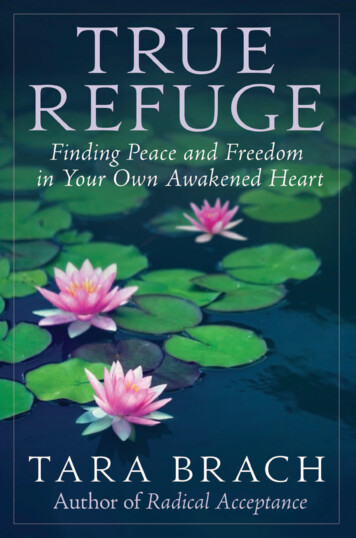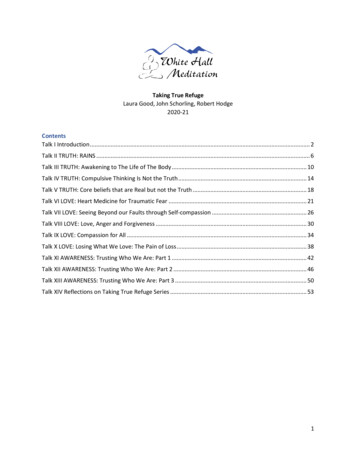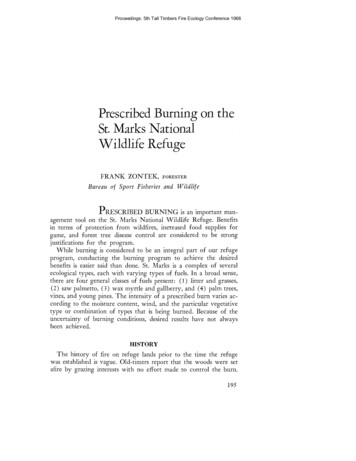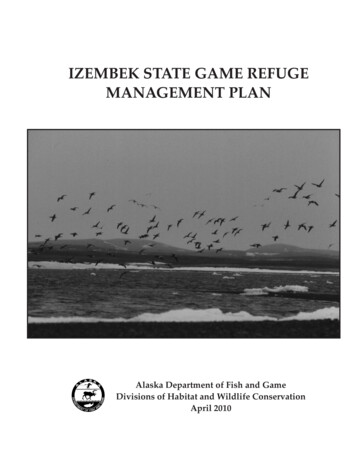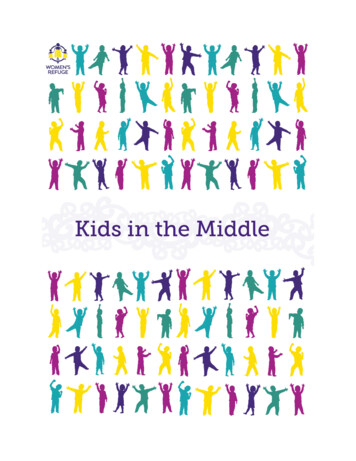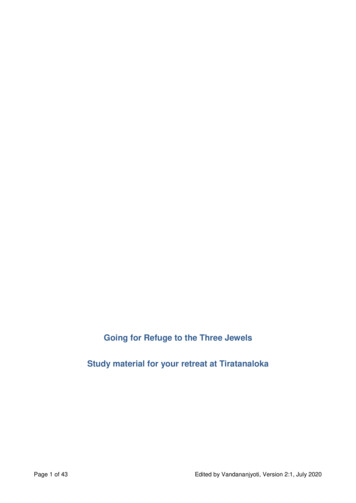
Transcription
Going for Refuge to the Three JewelsStudy material for your retreat at TiratanalokaPage 1 of 43Edited by Vandananjyoti, Version 2:1, July 2020
Table of ContentsIntroduction to the HandbookStudy Area 1. Centrality of Going for Refuge to the Three JewelsStudy Area 2. Going for Refuge to the Three JewelsStudy Area 3. Opening of the Dharma Eye and Stream EntryStudy Area 4. Going ForthStudy Area 5. The Altruistic Dimension of Going for Refuge and Joining theOrderPage 2 of 43Edited by Vandananjyoti, Version 2:1, July 2020
Introduction to the HandbookThe purpose of this handbook is to give you the opportunity to look in depth at the material that wewill be studying on the Going for Refuge to the Three Jewels retreat at Tiratanaloka.In this handbook we give you material to study for each area we’ll be studying on the retreat. Wewill also have some talks on the retreat itself where the team will bring out their own personalreflections on the topics covered.As well as the study material in this handbook, it would be helpful if you could readSangharakshita’s book ‘The History of My Going for Refuge’. You can buy this from WindhorsePublications.There is also some optional extra study material at the beginning of each section. Some of theoptional material is in the form of talks that can be downloaded from the Free Buddhist Audiowebsite at www.freebuddhistaudio.com. These aren’t by any means exhaustive - Free BuddhistAudio is growing and changing all the time so you may find other material equally relevant! Forexample, at the time of writing, Vessantara has just completed a series of talks called ‘Aspects ofGoing for Refuge’ (2016) at Cambridge Buddhist Centre.We’d ask you to study this material, reflect on it and come prepared with questions and areas youwould like to discuss as this will help you to get the most out of your retreat. You might even wantto study the material with some of your friends or talk about it with local Order Members.Throughout the material we’ve included questions about how the material relates to your ownpractice that we’d like you to think about in preparation for the discussion groups on the retreat.It’s important that you let us know if you have problems accessing any of the material we’ve askedyou to read, as we’ll be assuming that you have had a chance to look at it before you come.All of us on the team at Tiratanaloka look forward to studying the material with you when you comehere.Page 3 of 43Edited by Vandananjyoti, Version 2:1, July 2020
Study area 1. Centrality of Going for Refuge to the Three JewelsSummary and ReadingThe basis for Sangharakshita’s translation of the Dharma and the Buddhist Order he founded is hisunderstanding of the importance and significance of Going for Refuge to the Three Jewels. This isthe fundamental spiritual experience that unfolds into different aspects and depths. The first topicwe will be studying is an overview of the centrality of Going for Refuge to the Three Jewels inSangharakshita’s understanding of the breadth and depth of the Buddhist tradition. This involvesunderstanding the depth of this ‘central and definitive act’ in terms of the levels at which one canGo for Refuge, and the breadth in terms of the dimensions of how the act of Going for Refuge tothe Three Jewels changes our lives and effects us in all areas.Study MaterialIn 1981 Sangharakshita gave a talk called ‘Dimensions of Going for Refuge’, lecture 154, in whichhe outlined the levels and dimensions of Going for Refuge. This can be downloaded fromfreebuddhistaudio.com or as an ebook called ‘Going for Refuge’ on his websitewww.sangharakshita.org.You may also want to listen to his talk ‘Levels of Going for Refuge’, lecture 137, which he gave tothe Order in 1978.Subhuti goes into the levels of Going for Refuge in his paper ‘Initiation into a New Life’. This canbe found on his website www.subhuti.info, or in the book ‘The Seven Papers’.Going for Refuge to the Three Jewels(Edited by Vajratara from a talk given by Candraprabha in 2015)IntroductionThere are many ways in which to talk about Going for Refuge - for example you may have comeacross the framework of the System of Practice which gives us a way of looking at the work we doin order to make our Going for Refuge more effective in terms of Integration, Positive Emotion,Receptivity, Spiritual Death and Spiritual Rebirth. Sometimes we talk about Going for Refuge inthe context of spiritual friendship, ethics, or the central teaching of conditionality drawn out inChapter 1 of Sangharakshita’s ‘A Survey of Buddhism’. And of course all of this is to help usunderstand more about what Going for Refuge is about.On this retreat we are going to focus on Sangharakshita’s emphasis on Going for Refuge to theThree Jewels as the “central and definitive act of the Buddhist life”i and draw out some of theimplications of that. We will be looking at our response to the Three Jewels and their place in ourlives, giving us a sense of how our lives start to reorganise around them.Throughout the retreat we’re going to try and get a feel of how our Going for Refuge to the ThreeJewels affects the practical aspects of our life - in fact how it can turn our lives upside down andPage 4 of 43Edited by Vandananjyoti, Version 2:1, July 2020
move us in directions that we didn’t even know existed when we first learned to meditate or readour first Dharma book!The Centrality of Going for Refuge and LifestyleIf you have read ‘A History of my Going for Refuge’, you will know that, having taken ordinations indifferent traditions, and through what he calls ‘a process of discovery that follows a rather erraticcourse’, Sangharakshita eventually came to see that what united the different Buddhist traditions what in fact made one a Buddhist - was the act of Going for Refuge to the Three Jewels, and thereorganisation of one’s life around them. It’s easy to take this for granted, but the basis on whichthe Triratna Buddhist Order is founded is absolutely radical. Instead of dividing Buddhistpractitioners into monks and laypeople, we have a united Order based on a shared and deepeningcommitment, not lifestyle. There’s a lovely passage in ‘A History of my Going for Refuge’ whereSangharakshita talks about how, after he had initially created upāsaka/upāsikā ordinations i.e. laymen and women, (there would also be maha-upāsaka, novice bodhisattva and bhikshu or monasticordinations), he realised that those who had taken this ordination were doing more and hadreorganised their lives to an extent that was far beyond what ‘lay’ practitioners in other traditionswould be doing. So he changed the ordination and used the terms ‘Dharmachari’ and‘Dharmacharini’ which, while they appear in traditional texts, weren’t used by any other Buddhistschools. He started the Order and then saw what it was becoming and that helped clarify hisvision even further. At this point, the ordinations performed by Sangharakshita became separatefrom any particular sort of lifestyle. The principle behind our ordination became ‘commitment isprimary, lifestyle secondary’.The fact that the Movement and Order is founded on levels of commitment and not lifestyles canbe challenging. It’s something we have to continually reflect on – no-one is going to tell you whatto do, what to wear or what to chant. Many of us like that aspect of the Order, we like to make upour own minds about how to live. But the converse of this is that we sometimes want someone totell us what to do - or to tell other people what to do if we don’t agree with them! So what we havein Sangharakshita is someone who gives us the principles, but also gives us the responsibility ofworking out how we individually live them out or in the case of Going for Refuge, how to realisethem.Q: How do you relate to the principles behind which the Order was founded? Would youfind it easier to have more rules?It is worth remembering that Sangharakshita was in a historically unique situation. He had accessto all forms of Buddhism and was making sense of all the differing teachings, some of whichactually contradicted each other. For example, in the Theravada school into which he wasoriginally ordained, a Buddhist is defined by the number of precepts they take: lay followers taking5, and monks taking many more. In the Mahayāna, Buddhists are divided into those who havetaken the Bodhisattva vow, and those who haven’t. In Zen Buddhism it is meditation that isemphasised, and in Pure Land schools it is devotion. Looking at that array of lifestyles, spiritualideals, teachings and practices, he asked himself what united them as Buddhists? ForSangharakshita, it is that central act of Going for Refuge that unites all Buddhists.He also had an unprecedented understanding of how Buddhism had changed over time. He sawthat when practitioners lost sight of the fundamental importance of Going for Refuge itself, differentPage 5 of 43Edited by Vandananjyoti, Version 2:1, July 2020
methods started to appear that re-emphasised different aspects of that central act. For example,originally followers of the Buddha were often wanderers who only met in large numbers when themoon was full or when they observed the rainy season retreat. Over time they became moresettled and particular monastic practices became the focus over their Dharma practice: not eatingafter midday, how they wore their robes or keeping to a celibate lifestyle. These practices becameends in themselves, and the underlying commitment as to why they were undertaking them waslost. New teachings sprang up that re-emphasised altruism and the wandering lifestyle, using theexample of the Buddha himselfii. This re-emphasis was presented as higher teachings and it wasthought that the Buddha had given different teachings for people with different capabilities. As theBodhisattva path became more formulaic and lost its original vitality, new practices and lifestyleswere developed, such as the Maha-siddhas and the emergence of the Tantra. Sangharakshita’sperspective is that all these developments of Buddhism were a re-emphasis of different dimensionsof Going for Refuge, different ways of deepening and exploring that essential act of movingtowards the Going for Refuge as Buddhism ossifies towards formulaic practice. By identifying thelevels of Going for Refuge and the dimensions in which it’s experienced, Sangharakshita was ableto unify disparate branches of the Buddha Dharma.Different aspects of Going for RefugeSo what is Going for Refuge and how do we experience it?Firstly, Going for Refuge to the Three Jewels. Sangharakshita calls this ‘the emotional andvolitional aspect’ of this central Buddhist act’iii. He says this is fundamentally a turning from amundane way of life to a spiritual or transcendental way of life.iv We find we have something in ourlives that we want to move towards - a sense of something greater than ourselves, or even that weourselves have the potential to be something greater than we thought.What we do, in fact, when we Go for Refuge to the Three Jewels is to develop our ability torespond to higher values. The Three Jewels aren’t something ‘out there’, actually existing andseparate from us, even though when we are really struck by them that’s what it feels like. TheThree Jewels exist for us insofar as we are able to respond to something higher, somethingbeyond ourselves - a sense of the qualities of the Buddha, the beauty and clarity of the Dharma ormaybe the ethical practice of another person who is a bit further along the path than we are.Sangharakshita calls this a ‘total response’ in that is deeply and emotionally felt, as well as feelinga sense of clarity and understanding. He quotes the stock phrase in the Pali Canon. When theBuddha has ‘inspired, fired and delighted’ someone who he is with, they are overwhelmed withfeeling and they say:“It is amazing, Venerable Gotama, it is wonderful, Venerable Gotama! Just as if one might raise whathas been overturned, or reveal what has been hidden, or point out the way to him who has been lost,or hold out a lamp in the dark so that those who have eyes may see; so likewise has the Truth beenexplained by Venerable Gotama in many ways. Therefore I go for refuge to him, his Dhamma and hisSangha. I wish to enter the homeless life and to receive ordination near the Venerable Gotama.”vSecondly, the Opening of the Dharma Eye and Stream Entry. Sangharakshita calls this ‘theunconditioned depth of the cognitive content’vi of Going for Refuge, and the ‘permanent and farreaching nature of its effects’. This means how we actually experience the nature of reality, seeingPage 6 of 43Edited by Vandananjyoti, Version 2:1, July 2020
truths such as impermanence more directly as we practise more intensively, and how that changesus. We experience ourselves and others as less fixed, and we experience less doubt and moreclarity.Thirdly, Going Forth. Sangharakshita calls this ‘the extent of reorganisation in the pattern of dailylife’vii. Our forward momentum will involve a reorganisation in our lives, both internally andexternally, and a move away from things that we realise can no longer fully satisfy us.And finally the aspect of Altruism. This is the ‘other regarding attitude’viii of Going for Refuge. OurGoing for Refuge will involve a change in our relationship with the world, with other people and willbecome more based on mettā as we become more aware of what we can give, and as we becomeless and less self-orientated.Q: which aspect of Going for Refuge do we feel most attracted to, and which one do we findmost challenging?Levels of Going for RefugeWhat Sangharakshita has also drawn out is that these aspects of Going for Refuge can bepractised and experienced at deepening levels. The terms here are the ones that Subhuti used inhis paper ‘Initiation into a New Life’.So the 5 levels are Cultural, Provisional, Effective, Real and Absolute. Subhuti refers to themas levels of commitment. This implies Going for Refuge is a dynamic of being able to commitourselves more and more fully to the Buddhist path, and in particular, this Buddhist movement. Itemphasises that ‘commitment is primary’, just as ‘lifestyle is secondary’.Cultural Going for Refuge is not truly a commitment, but more of an allegiance to Buddhism aspart of social group to which one belongs. This is more obvious to see in ethnically Buddhistcountries, but is also emerging in non-Buddhist countries as Buddhism becomes more popularamongst certain groups of people.Q: What does cultural Going for Refuge look like in the West?Provisional Going for Refuge is when we are attracted to the Three Jewels as ideals, we want tocommit to Buddhism, we have moments of temporary inspiration or insight, but not yet enoughweight to make that inspiration sustained. We may have other competing emotional and practicalpulls in our lives, and we fit the Dharma around our lives. There may be areas in which we areaware we are holding back, and are not yet sufficiently sure to be wholehearted about our practice.This is the level at which we become a ‘mitra’.Sometimes we can use the term ‘Going for Refuge’ as a sort of shorthand for ‘asking forordination’ e.g. we say someone is a ‘Going for Refuge mitra’ meaning someone who has askedfor ordination. This can imply that people (including mitras) who haven’t asked for ordinationaren’t Going for Refuge. It is worth reminding ourselves at this point that the levels of Going forRefuge describe the way that our Going for Refuge deepens as we deepen our commitment to theThree Jewels, it doesn’t start when one asks for ordination, nor is it confined to our BuddhistMovement.Page 7 of 43Edited by Vandananjyoti, Version 2:1, July 2020
Effective Going for Refuge is when, as Subhuti describes, we have a ‘compelling glimpse of whatlies beyond self-clinging’ix. This means we reorganise our lives so that we fit our lives around theDharma, rather than the Dharma around our lives. We are sufficiently integrated psychologically toget our energy behind our Going for Refuge though we are still dependent on willed effort andconditions. Part of effective Going for Refuge is that we realise how much effort it will take and theconditions we need to progress. Shantideva says it still requires a lot of effort simply to stay stillbecause we are always under the sway of the worldly winds:‘Swinging back and forth like this in cyclic existence, now under the sway of errors, now under thesway of the Awakening Mind, it takes a long time to gain ground. Therefore I must diligently fulfilwhat I have promised. If I make no effort today I shall sink to lower and lower levels’xEffective Going for Refuge is the level which is equated with ordination, so it’s important tounderstand what it means for us in our own lives.Q: What does effective Going for Refuge look like? You may want to read Subhuti’s paperand listen to Sangharakshita’s talks to get a feel of it. What do you need to work on next tomake your provisional Going for Refuge effective?Real Going for Refuge is the level that is usually equated with the arising of irreversible Insight orstream entry. At this point Subhuti says we are co-operating Dharma-niyāma processes whichbecome more of a force in our lives than self-clinging. Before real Going for Refuge we can fallback, but at this point we are definitely moving towards Enlightenment, our practice is notdependent on external conditions. You could say at this point that we are less concerned with ourprogress for our own sake: our wellbeing is inextricably tied up with the wellbeing of othersbecause we really see with our hearts that we are not separate from others. It is this broaderperspective that guides our actions of body, speech and mind.Absolute Going for Refuge is reached when we attain Enlightenment. We become part of a flowof non-egoistic volition. There is not much that can be said about this level because it transcendsconcepts. As Sangharakshita says ‘At this level one doesn’t go to any Refuge outside oneself.One is one’s own Refuge. In fact, on this level there’s no inside and no outside because there’s noself and no other, and one cannot really say any more than this.’xiIt is important not to see these as real existing discrete levels, there is a continuum of commitmentwith a back and forth movement until we reach Real Going for Refuge at which point ourmomentum is irreversible - at that point we can’t help but go forward, however difficult that may be.Q: Have we noticed our commitment deepen over time? What has helped? What are theareas where we notice ourselves holding back?Use of the term Going for RefugeYou’ve probably found yourself and others at times talking about wanting to ‘deepen my Going forRefuge’. Talking in this way is second nature to us in Triratna - the idea that Going for Refuge issomething that we’re constantly trying to take to deeper and deeper levels. It’s easy to forget thatthis concept is very much part of Sangharakshita’s particular presentation of the Dharma and wemay notice that other writers on Buddhism don’t use this phrase. In other traditions they might talkPage 8 of 43Edited by Vandananjyoti, Version 2:1, July 2020
about ‘realising the nature of mind’ or ‘developing bodhicitta’ or ‘understanding emptiness’ or‘undertaking the path of purification’. In other traditions, Going for Refuge is seen as a preliminarypractice or even something that is done at a relatively superficial level - reciting the refuges andprecepts to show one is a Buddhist. But for us, practising within Triratna, we use the term Goingfor Refuge in a different way: the central act of a Buddhist that can be undertaken at ever deeperlevels and that unfolds in different dimensions.Working with the particular and the universalSangharakshita points out that Going for Refuge is twofold, general (or universal) and specific (orparticular)xii. When working towards effective Going for Refuge and beyond we need tounderstand ourselves: our habitual responses to things, our conditioning, the psychologicalmakeup that causes us to see other people, situations and the world in the way we do. This is thespecific or particular way in which we Go for Refuge.Alongside this, we need to have a Dharmic framework for our experience as human beings, tounderstand in a wider context what our practice is for. We need what Sangharakshita calls ‘acontext wider than the individual’s own personal life’. We need to understand what dukkha is, howwe experience it in common with all other beings. We need to understand the significance of ourown wish to go beyond dukkha and use the path that has been shown to us by the Buddha. This isthe universal or general way in which we Go for Refuge.Why is it important to look at our practice from both these perspectives - what we might call theparticular and the universal perspectives?Taking the example of the mettā bhāvana practice, we might be tempted to push our real feelingsaway to try and force a connection with our ideals, our wish to feel positive and connected. Thismay work to a certain extent, we may bring in something more positive that for a period of timethan the feelings we started with. But the chances are that if we don’t recognise and sympathiseand work with our real responses then they will come back, again and again. So we need to payattention to the particular, the specific, and not leave ourselves out of the picture.On the other hand, we might also go into an analysis of our mental states - tracing them back towhat we think are the roots, wondering about our relationships with others that might have sparkedoff those feelings, indulging in some familiar stories about why we are the way we are. In thiscase, we can lose sight of what we’re actually trying to do in the practice - to go beyond a fixed andlimited sense of self and to deeply empathise with other beings. So we might need to pay moreattention to the universal - seeing the bigger picture in terms of the teachings of the Dharma andkeeping a sense of the overall perspective of what we are doing.There is a need to have a balance between understanding the particulars of our own character andseeing the universality of our experience as human beings that is quite key to the area of workingto deepen our Going for Refuge generally, not just in meditation. If we focus too much on theuniversal, we can go a bit abstract and it’s hard to be specific enough to work on things in a waythat really makes a difference. We need to work out what the Dharma means for us individually.On the other hand, if we concentrate too much on the details of our own psyche we can get stuck,see ourselves as nothing more than the product of our conditioning, and lose sight of the biggerPage 9 of 43Edited by Vandananjyoti, Version 2:1, July 2020
context. In that case we need to reflect more deeply on what the significance of our experience is,using the framework of the Dharma.Q: It might be interesting to look at whether we tend to communicate about our practicefrom the ‘particular’ aspect or the ‘universal’ aspect. Do we need to communicate our ownexperience more, or do we need to contextualise our individual experience in the light of theDharma? How can we work with these tendencies?ConclusionWe all know a lot about what it means to go for refuge because we’ve spent our entire lives goingfor refuge to one thing or another. The Buddha says in the Dhammapada: ‘Many people, out offear, flee for refuge to sacred hills, woods, groves, trees and shrines. In reality this is not a saferefuge. In reality this is not the best refuge. Fleeing to such a refuge one is not released from allsuffering. He who goes for refuge to the Enlightened One, to the Truth, and the SpiritualCommunity. for him this is a safe refuge, for him this is the best refuge. Having gone to such arefuge, one is released from all suffering’xiii. We believe - or perhaps even just hope - that there’ssomething that will give us satisfaction, will give us purpose, will shield us from all the instabilityand unpredictability of life in the human realm - it may not be hills, groves and trees for us, maybefor us it’s our job, family, partner, drugs, the perfect place to live.If you read the stories of how and who the Buddha taught, over and over, he engaged with peoplefrom all walks of life - men, women, mothers, kings, farmers, courtesans, businessmen - showingthem how the Dharma could overcome the particular difficulties they experienced as a result ofsimply being human beings. In the seminar on the Bodhicaryāvatāra which was given in the veryearly days of the movement, Sangharakshita reflects on how Triratna (or The Friends as he calls itthere) was developing along the same lines as the early Sangha. People with existential questionsabout life saw something that had a flavour of truth and freedom - often they saw it throughencountering someone who seemed to be a bit different and getting into dialogue with them - andthat was how their Going for Refuge started. So we’re all very different, we’ve got differentquestions and our connections to the Three Jewels will be very different. But I think we can oftenhave a sense of something similar too - what the Buddha called the taste of freedom. And havingGoing for Refuge as the central act allows us to see clearly what we have in common and to worktogether towards that release from suffering for ourselves and others.Page 10 of 43Edited by Vandananjyoti, Version 2:1, July 2020
Study area 2. Going for Refuge to the Three JewelsSummary and ReadingThe second topic we will be studying on this retreat is what the act Going for Refuge to the ThreeJewels looks and feels like in experience. This involves looking at the quest we undertake as wesearch for a true and enduring refuge, how we find a true refuge, and once found, how we committo taking refuge there.Study MaterialSangharakshita gave a talk in 1965, lecture 9, on ‘Going for Refuge’, which is part of his series on‘The Meaning of Conversion in Buddhism’. The whole series can be downloaded fromfreebuddhistaudio.com, or as an ebook from his website www.sangharakshita.org.Going for Refuge to the Three Jewels(Edited from a talk given by Vajratara in 2014)The QuestIn the last section we looked at the momentum of Going for Refuge to the Three Jewels as being amovement towards liberation. So what are moving away from? The most immediate answer isthat we are moving away from dukkha, or suffering, unsatisfactoriness. This can be experienced interms of something going wrong in one’s life, for example a death or a separation, critical illness orloss in some form. It can also be experienced as a deeper sense of unsatisfactoriness: that thingsare okay on their own level, but that they don’t go deep enough, the don’t fulfil the deeper longingsof the human heart. One way we could examine this movement is to look at the life of the Buddha.As a young man, the Buddha looked closely at his experience of his life, he thought deeply about itand he asked questions of it. Paradoxically, in order to free himself from suffering, he had to movetowards it and reflect on it more deeply. We are told that he saw people struggling, in conflict,taking up arms against each other, struggling like fish in a pond fast drying out. He tells us that hewas afraid when he saw these things, he shook with terror. He longed to find a place of shelter,but there is nothing in this world that is solid, not a part of it that is changelessxiv.We are told he saw sickness, ageing and death; sights that inspire in most people feelings ofshock, humiliation and disgust. He saw that he too would get sick, old and die. It is said that thevanity of health, youth and life entirely left himxv.While the Buddha saw old age, sickness, death, conflict, he also saw that the reason for all thisconflict and suffering is a thorn, lodged deep in the heart. And he saw that this thorn can be takenoutxvi.He went on a quest, which in pali is ‘pariyesanā’, literally meaning to seek, search, look for, ordesire. It is a strongly emotional and volitional word, not simply an intellectual idea. He longed toescape from what is incapable of giving lasting satisfaction, from what we may term a ‘falserefuge’, to find what might give him lasting satisfaction. This is what we might term a ‘true refuge’,Page 11 of 43Edited by Vandananjyoti, Version 2:1, July 2020
something that, in his words, can offer a ‘supreme security from bondage’xvii (yogakhema). TheBuddha called the search for a true refuge ‘the noble quest’ (ariyāpariyesanā) in contrast to thesearch for a false refuge, ‘the ignoble quest’ (anariyāpariyesanā), in which we go in search ofthings that cannot satisfy, that are also subject to change, just as we are.Q: Does the language of a ‘quest’ resonate with your own experience? How do you imagineyour own spiritual journey?Questing for the True RefugeSo how can we distinguish between a true and false refuge? What are we searching for in ournoble quest? If we know what the basic criteria are, we will find it easier to know if we have foundwhat we are truly looking for. What we are looking for is a refuge that is: Permanent: not that there is no movement in a true refuge, but that our refuge is beyondthe reach of change, beyond the reach of death. It is always true, always of value, despitethe changing conditions that surround it. Sometimes we catch a glimpse of this when weexperience a great loss, for example someone dies, and our whole idea of our life isquestioned. We are forced to ask what is of most value to us? What are the values notshaken by death – our own or others?Limitless: we need something, or some value, that is limitless. Otherwise we get to a pointwhere we can’t go any further. People can often find this with different kinds of therapy.We can get to a certain point, perhaps finding the root of our health or psychologicaldifficulties, but what next? Sometimes it is unclea
Go for Refuge, and the breadth in terms of the dimensions of how the act of Going for Refuge to the Three Jewels changes our lives and effects us in all areas. Study Material In 1981 Sangharakshita gave a talk called 'Dimensions of Going for 5efuge', lecture 154, in which he outlined the levels and dimensions of Going for Refuge.


